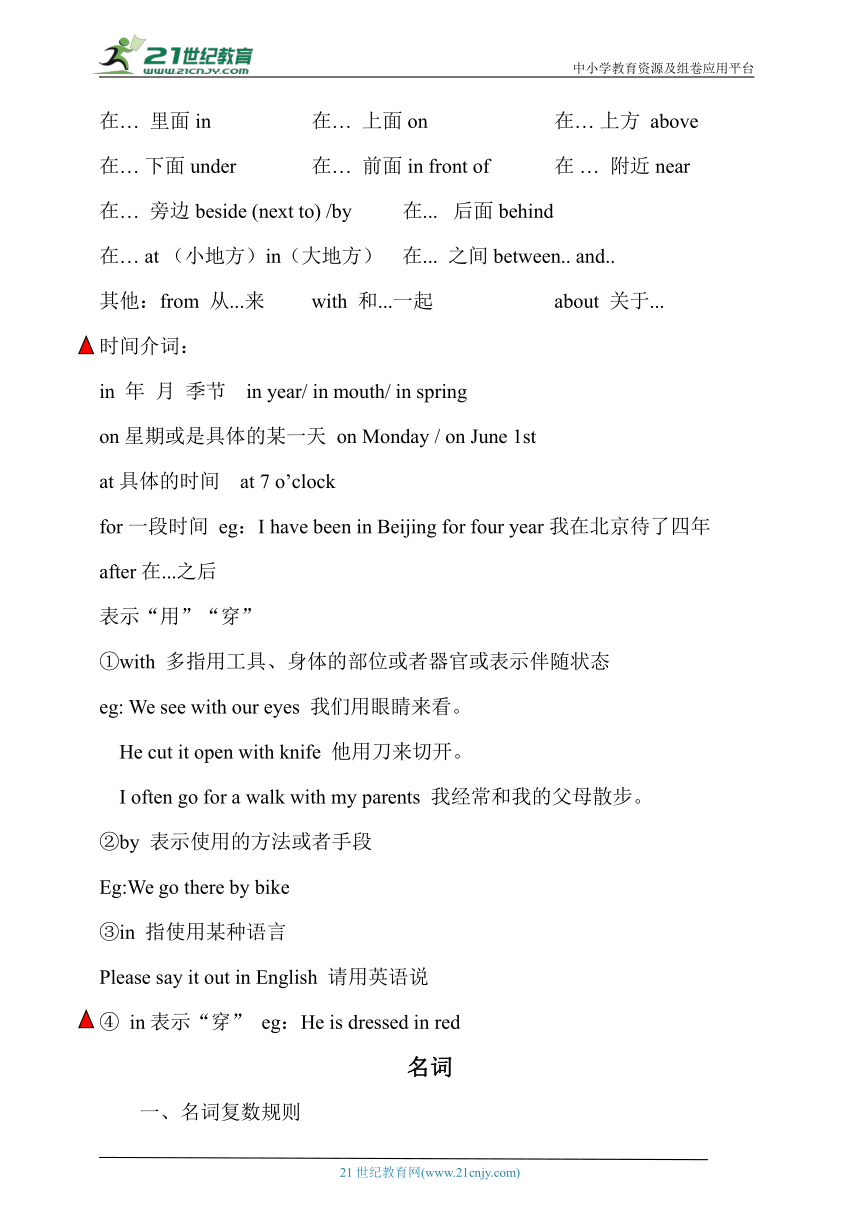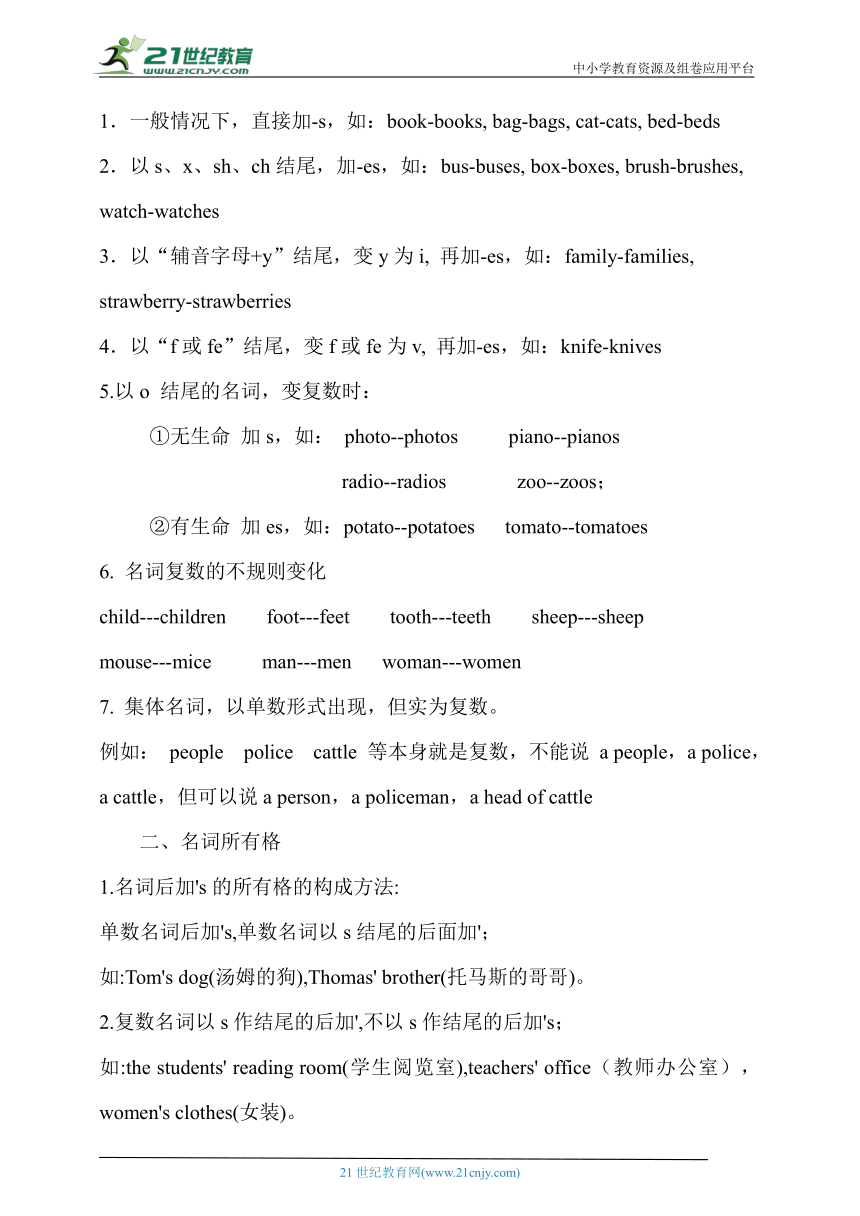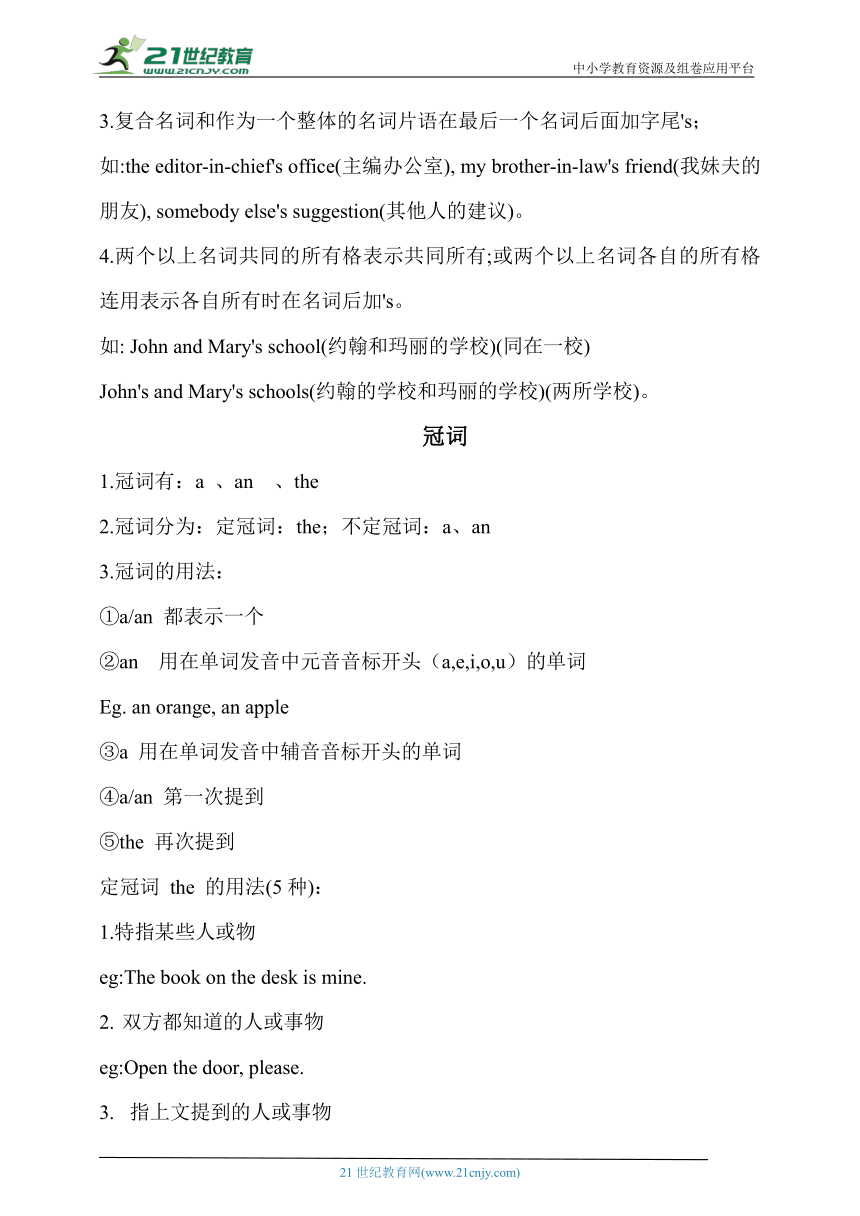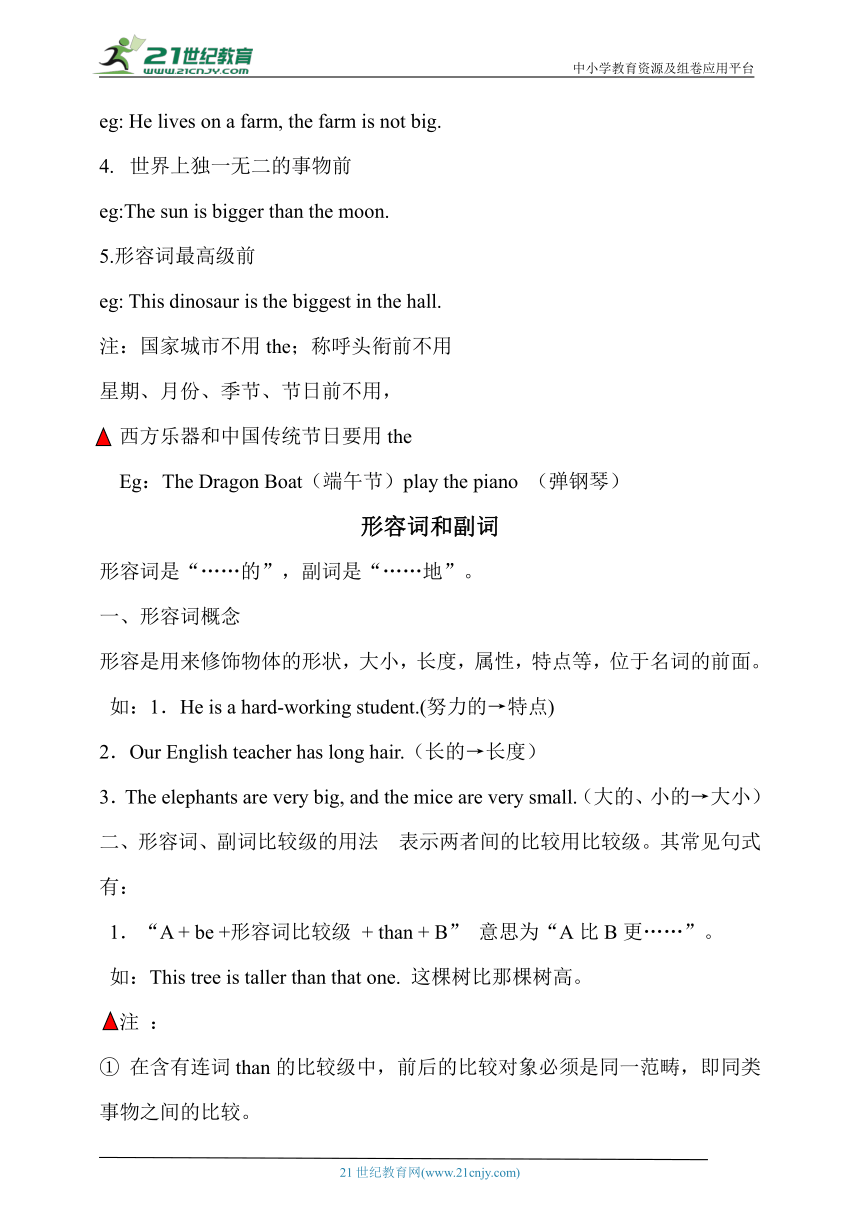2024年人教版 PEP 小升初英语语法点复习归纳
文档属性
| 名称 | 2024年人教版 PEP 小升初英语语法点复习归纳 |  | |
| 格式 | doc | ||
| 文件大小 | 446.0KB | ||
| 资源类型 | 试卷 | ||
| 版本资源 | 人教版(PEP) | ||
| 科目 | 英语 | ||
| 更新时间 | 2024-04-16 14:42:20 | ||
图片预览





文档简介
中小学教育资源及组卷应用平台
人教版 PEP 小升初英语语法点复习归纳
代词
①人称代词
主格: I you he she it we they
我 你(你们) 他 她 它 我们 他/她/它们
宾格: me you him her it us them
我 你(你们) 他 她 它 我们 他/她/它们
adj.物代: my your his her its our their
我的 你的 他的 她的 它的 我们的 他/她/它们的
N.物代: mine yours his hers its ours yours theirs
我的 你的 他的 她的 它的 我们的 你们的 他们的
形容词性物主代词和名词性物主代词的用法:
有名则形,无名则名,后面有名词一定要形容词性
②指示代词:
指示代词专门用来指出或表示人或物
this这个 that 那个
these(this复数) those(that复数)
this和these一般指在时间或空间上较近的人或事物
that和those一般指时间和空间上较远的人或者事物
介词
一、方位介词 :
在… 里面in 在… 上面on 在… 上方 above
在… 下面under 在… 前面in front of 在 … 附近near
在… 旁边beside (next to) /by 在... 后面behind
在… at (小地方)in(大地方) 在... 之间between.. and..
其他:from 从...来 with 和...一起 about 关于...
时间介词:
in 年 月 季节 in year/ in mouth/ in spring
on星期或是具体的某一天 on Monday / on June 1st
at具体的时间 at 7 o’clock
for一段时间 eg:I have been in Beijing for four year我在北京待了四年
after在...之后
表示“用”“穿”
①with 多指用工具、身体的部位或者器官或表示伴随状态
eg: We see with our eyes 我们用眼睛来看。
He cut it open with knife 他用刀来切开。
I often go for a walk with my parents 我经常和我的父母散步。
②by 表示使用的方法或者手段
Eg:We go there by bike
③in 指使用某种语言
Please say it out in English 请用英语说
④ in表示“穿” eg:He is dressed in red
名词
名词复数规则
1.一般情况下,直接加-s,如:book-books, bag-bags, cat-cats, bed-beds
2.以s、x、sh、ch结尾,加-es,如:bus-buses, box-boxes, brush-brushes, watch-watches
3.以“辅音字母+y”结尾,变y为i, 再加-es,如:family-families, strawberry-strawberries
4.以“f或fe”结尾,变f或fe为v, 再加-es,如:knife-knives
5.以o 结尾的名词,变复数时:
①无生命 加s,如: photo--photos piano--pianos
radio--radios zoo--zoos;
②有生命 加es,如:potato--potatoes tomato--tomatoes
6. 名词复数的不规则变化
child---children foot---feet tooth---teeth sheep---sheep
mouse---mice man---men woman---women
集体名词,以单数形式出现,但实为复数。
例如: people police cattle 等本身就是复数,不能说 a people,a police,a cattle,但可以说a person,a policeman,a head of cattle
名词所有格
1.名词后加's的所有格的构成方法:
单数名词后加's,单数名词以s结尾的后面加';
如:Tom's dog(汤姆的狗),Thomas' brother(托马斯的哥哥)。
2.复数名词以s作结尾的后加',不以s作结尾的后加's;
如:the students' reading room(学生阅览室),teachers' office(教师办公室),women's clothes(女装)。
3.复合名词和作为一个整体的名词片语在最后一个名词后面加字尾's;
如:the editor-in-chief's office(主编办公室), my brother-in-law's friend(我妹夫的朋友), somebody else's suggestion(其他人的建议)。
4.两个以上名词共同的所有格表示共同所有;或两个以上名词各自的所有格连用表示各自所有时在名词后加's。
如: John and Mary's school(约翰和玛丽的学校)(同在一校)
John's and Mary's schools(约翰的学校和玛丽的学校)(两所学校)。
冠词
1.冠词有:a 、an 、the
2.冠词分为:定冠词:the;不定冠词:a、an
3.冠词的用法:
①a/an 都表示一个
②an 用在单词发音中元音音标开头(a,e,i,o,u)的单词
Eg. an orange, an apple
③a 用在单词发音中辅音音标开头的单词
④a/an 第一次提到
⑤the 再次提到
定冠词 the 的用法(5种):
1.特指某些人或物
eg:The book on the desk is mine.
双方都知道的人或事物
eg:Open the door, please.
指上文提到的人或事物
eg: He lives on a farm, the farm is not big.
世界上独一无二的事物前
eg:The sun is bigger than the moon.
5.形容词最高级前
eg: This dinosaur is the biggest in the hall.
注:国家城市不用the;称呼头衔前不用
星期、月份、季节、节日前不用,
西方乐器和中国传统节日要用the
Eg:The Dragon Boat(端午节)play the piano (弹钢琴)
形容词和副词
形容词是“……的”,副词是“……地”。
一、形容词概念
形容是用来修饰物体的形状,大小,长度,属性,特点等,位于名词的前面。
如:1.He is a hard-working student.(努力的→特点)
2.Our English teacher has long hair.(长的→长度)
3.The elephants are very big, and the mice are very small.(大的、小的→大小)
二、形容词、副词比较级的用法 表示两者间的比较用比较级。其常见句式有:
1.“A + be +形容词比较级 + than + B” 意思为“A比B更……”。
如:This tree is taller than that one. 这棵树比那棵树高。
注 :
① 在含有连词than的比较级中,前后的比较对象必须是同一范畴,即同类事物之间的比较。
②在比较级前面使用much,表示程度程度“强得多”。 如:A watermelon is much bigger than an apple.
③ very, quite一般只能修饰原级,不能修饰比较级。
Eg:very good 很棒 good就是原级
在含有or的选择疑问句中,如果有两者供选择,前面的形容词要用比较级形式。
如:Who is taller,Tim or Tom 谁更高,Tim还是Tom
三、形容词、副词的最高级的用法
形容词、副词的最高级形式主要用来表示三者或三者以上人或事物的比较,表示“最……”的意思。句子中有表示范围的词或短语。
如:of the three, in our class等等。
如:He is the tallest in our class. 他在我们班里是最高的。
形容词最高级前一定要有定冠词the,而副词最高级前则不需要。
形容词、副词的比较级和最高级的构成规则
一般情况下,比较级在后面加-er,最高级在后面加-est;
如:small→smaller→smallest short→shorter→shortest
2.在重读闭音节(即:辅音+元音+辅音)中,先双写末尾的辅音字母,比较级加-er,最高级加-est; 如:big→bigger→biggest hot→hotter→hottest
3.以不发音e结尾的单音节词,比较在原级后加-r,最高级在原级后加-st; 如:large→larger→largest nice→nicer→nicest
4.以“辅音字母+y”结尾的双音节词, 把y改为i,比较级加-er,最高级加-est; 如:easy→easier→easiest heavy→heavier→heaviest
5.多数多音节词,比较级在前面加more,最高级在前面加most;
如:beautiful→more beautiful→most beautiful different→more different→most different
有少数形容词、副词的比较级和最高级是不规则的,必须熟记。
如:good→better→best bad→worse→worst old→elder→eldest many/much→more→most little→less→least
far →further/farther→ furthest/farthest
四大时态
一、一般现在时
1.重点:(句子特征;以及第三人称动词的变化原则 )
2. 句子出现的时间标志为:often, usually,sometime, everyday,…等词汇)
eg: I often go to school by bike.
He often goes to school by bike.
第三人称单数,动词要变复数!
3. 动词变化规则:
①一般情况下,直接加-s,如:cook-cooks, milk-milks,climbs,cleans
②以s. x. sh. ch. o结尾,加-es,如:guess-guesses, wash-washes, watch-watches, go-goes
③以“辅音字母+y”结尾,变y为i, 再加-es,如:study-studies
④have-has
二、正在进行时
1.概念:表示正在进行的动作。
2.重点时间标志词汇:now, look, listen(放句子开头)
3.句型结构:be+动词ing. eg:The cat is chasing a mouse now.
4. 动词+ing变化规则:
①一般情况下,直接加ing,如:cook-cooking, playing,watching
②以不发音的e结尾,去e加ing,如:make-making, taste-tasting
③如果末尾是一个元音字母和一个辅音字母,双写末尾的辅音字母,再加ing,如:run-running, stop-stopping,
④少数几个以ie结尾的,须将ie变为y再加ing。如:die-dying,lie-lying
三、一般将来时
1.概念:表示将来或则即将要发生的事情。
2.句型结构: be going to
eg:I am going to Beijing next month.
3.句子重点时间标志词汇: next month/day/year/weekend,soon, tomorrow
四、一般过去时
1.概念:表示发生在过去的事情或则动作。
2.句子重点时间标志词汇: yesterday, last month/year/weekend, just now, five years ago,……
Eg: I went to the park yesterday.我昨天去了公园
3. 动词过去式变化规则:
①一般在动词末尾加-ed,如:jumped,cooked,worked, played, wanted
②结尾是e加d,如:tasted,lived,moved,hoped
③末尾只有一个元音字母和一个辅音字母的重读闭音节,应双写末尾的辅音字母,再加-ed,如:stop-stopped
④以“辅音字母+y”结尾的,变y为i, 再加-ed,如:study-studied
注:不规则动词的过去式变化规律性不强,须多加记忆。
go - went make - made get - got
buy - bought come - came can-could
is/am-was are-were do-did
see-saw sleep-slept fall—fell
take-took say-said sit-sat
buy-bought give-gave eat-ate sit-sat write-wrote feel-felt
tell-told find-found hear-heard
know-knew grow-grew take-took
ride-rode come-came swim-swam
become-became sweep—swept sing—sang
draw—drew read-read
五、Have、Has和There be结构
1.There be结构包括there is/ there are /there was /there were
There be 句型表示:
在there be 句型中,如有几件物品,be 动词根据最近be 动词的那个名词决定。 例如:
There is a chair and two end tables in my bedroom.
和have、has、had的区别:
①在have之前必定有一个某人,例如: I have a notebook.
②第三人称单数用has 例如:He has a storybook.
③过去式用had 例如:She had a cold yesterday.
六、祈使句
概念:表示请求或命令,建议,禁止别人做某事或不要做某事。
①动词开头,Go away,Sit down,Stand up,Come here
②Let 开头 表达请求或建议,Let’s go!
③don’t + 动词!不要做某事,Don’t worry!
④be + 形容词!Be quiet!Be careful!
⑤以NO开头 公共警示语,提倡文明行为 No photos , No fishing
21世纪教育网 www.21cnjy.com 精品试卷·第 2 页 (共 2 页)
HYPERLINK "http://21世纪教育网(www.21cnjy.com)
" 21世纪教育网(www.21cnjy.com)
人教版 PEP 小升初英语语法点复习归纳
代词
①人称代词
主格: I you he she it we they
我 你(你们) 他 她 它 我们 他/她/它们
宾格: me you him her it us them
我 你(你们) 他 她 它 我们 他/她/它们
adj.物代: my your his her its our their
我的 你的 他的 她的 它的 我们的 他/她/它们的
N.物代: mine yours his hers its ours yours theirs
我的 你的 他的 她的 它的 我们的 你们的 他们的
形容词性物主代词和名词性物主代词的用法:
有名则形,无名则名,后面有名词一定要形容词性
②指示代词:
指示代词专门用来指出或表示人或物
this这个 that 那个
these(this复数) those(that复数)
this和these一般指在时间或空间上较近的人或事物
that和those一般指时间和空间上较远的人或者事物
介词
一、方位介词 :
在… 里面in 在… 上面on 在… 上方 above
在… 下面under 在… 前面in front of 在 … 附近near
在… 旁边beside (next to) /by 在... 后面behind
在… at (小地方)in(大地方) 在... 之间between.. and..
其他:from 从...来 with 和...一起 about 关于...
时间介词:
in 年 月 季节 in year/ in mouth/ in spring
on星期或是具体的某一天 on Monday / on June 1st
at具体的时间 at 7 o’clock
for一段时间 eg:I have been in Beijing for four year我在北京待了四年
after在...之后
表示“用”“穿”
①with 多指用工具、身体的部位或者器官或表示伴随状态
eg: We see with our eyes 我们用眼睛来看。
He cut it open with knife 他用刀来切开。
I often go for a walk with my parents 我经常和我的父母散步。
②by 表示使用的方法或者手段
Eg:We go there by bike
③in 指使用某种语言
Please say it out in English 请用英语说
④ in表示“穿” eg:He is dressed in red
名词
名词复数规则
1.一般情况下,直接加-s,如:book-books, bag-bags, cat-cats, bed-beds
2.以s、x、sh、ch结尾,加-es,如:bus-buses, box-boxes, brush-brushes, watch-watches
3.以“辅音字母+y”结尾,变y为i, 再加-es,如:family-families, strawberry-strawberries
4.以“f或fe”结尾,变f或fe为v, 再加-es,如:knife-knives
5.以o 结尾的名词,变复数时:
①无生命 加s,如: photo--photos piano--pianos
radio--radios zoo--zoos;
②有生命 加es,如:potato--potatoes tomato--tomatoes
6. 名词复数的不规则变化
child---children foot---feet tooth---teeth sheep---sheep
mouse---mice man---men woman---women
集体名词,以单数形式出现,但实为复数。
例如: people police cattle 等本身就是复数,不能说 a people,a police,a cattle,但可以说a person,a policeman,a head of cattle
名词所有格
1.名词后加's的所有格的构成方法:
单数名词后加's,单数名词以s结尾的后面加';
如:Tom's dog(汤姆的狗),Thomas' brother(托马斯的哥哥)。
2.复数名词以s作结尾的后加',不以s作结尾的后加's;
如:the students' reading room(学生阅览室),teachers' office(教师办公室),women's clothes(女装)。
3.复合名词和作为一个整体的名词片语在最后一个名词后面加字尾's;
如:the editor-in-chief's office(主编办公室), my brother-in-law's friend(我妹夫的朋友), somebody else's suggestion(其他人的建议)。
4.两个以上名词共同的所有格表示共同所有;或两个以上名词各自的所有格连用表示各自所有时在名词后加's。
如: John and Mary's school(约翰和玛丽的学校)(同在一校)
John's and Mary's schools(约翰的学校和玛丽的学校)(两所学校)。
冠词
1.冠词有:a 、an 、the
2.冠词分为:定冠词:the;不定冠词:a、an
3.冠词的用法:
①a/an 都表示一个
②an 用在单词发音中元音音标开头(a,e,i,o,u)的单词
Eg. an orange, an apple
③a 用在单词发音中辅音音标开头的单词
④a/an 第一次提到
⑤the 再次提到
定冠词 the 的用法(5种):
1.特指某些人或物
eg:The book on the desk is mine.
双方都知道的人或事物
eg:Open the door, please.
指上文提到的人或事物
eg: He lives on a farm, the farm is not big.
世界上独一无二的事物前
eg:The sun is bigger than the moon.
5.形容词最高级前
eg: This dinosaur is the biggest in the hall.
注:国家城市不用the;称呼头衔前不用
星期、月份、季节、节日前不用,
西方乐器和中国传统节日要用the
Eg:The Dragon Boat(端午节)play the piano (弹钢琴)
形容词和副词
形容词是“……的”,副词是“……地”。
一、形容词概念
形容是用来修饰物体的形状,大小,长度,属性,特点等,位于名词的前面。
如:1.He is a hard-working student.(努力的→特点)
2.Our English teacher has long hair.(长的→长度)
3.The elephants are very big, and the mice are very small.(大的、小的→大小)
二、形容词、副词比较级的用法 表示两者间的比较用比较级。其常见句式有:
1.“A + be +形容词比较级 + than + B” 意思为“A比B更……”。
如:This tree is taller than that one. 这棵树比那棵树高。
注 :
① 在含有连词than的比较级中,前后的比较对象必须是同一范畴,即同类事物之间的比较。
②在比较级前面使用much,表示程度程度“强得多”。 如:A watermelon is much bigger than an apple.
③ very, quite一般只能修饰原级,不能修饰比较级。
Eg:very good 很棒 good就是原级
在含有or的选择疑问句中,如果有两者供选择,前面的形容词要用比较级形式。
如:Who is taller,Tim or Tom 谁更高,Tim还是Tom
三、形容词、副词的最高级的用法
形容词、副词的最高级形式主要用来表示三者或三者以上人或事物的比较,表示“最……”的意思。句子中有表示范围的词或短语。
如:of the three, in our class等等。
如:He is the tallest in our class. 他在我们班里是最高的。
形容词最高级前一定要有定冠词the,而副词最高级前则不需要。
形容词、副词的比较级和最高级的构成规则
一般情况下,比较级在后面加-er,最高级在后面加-est;
如:small→smaller→smallest short→shorter→shortest
2.在重读闭音节(即:辅音+元音+辅音)中,先双写末尾的辅音字母,比较级加-er,最高级加-est; 如:big→bigger→biggest hot→hotter→hottest
3.以不发音e结尾的单音节词,比较在原级后加-r,最高级在原级后加-st; 如:large→larger→largest nice→nicer→nicest
4.以“辅音字母+y”结尾的双音节词, 把y改为i,比较级加-er,最高级加-est; 如:easy→easier→easiest heavy→heavier→heaviest
5.多数多音节词,比较级在前面加more,最高级在前面加most;
如:beautiful→more beautiful→most beautiful different→more different→most different
有少数形容词、副词的比较级和最高级是不规则的,必须熟记。
如:good→better→best bad→worse→worst old→elder→eldest many/much→more→most little→less→least
far →further/farther→ furthest/farthest
四大时态
一、一般现在时
1.重点:(句子特征;以及第三人称动词的变化原则 )
2. 句子出现的时间标志为:often, usually,sometime, everyday,…等词汇)
eg: I often go to school by bike.
He often goes to school by bike.
第三人称单数,动词要变复数!
3. 动词变化规则:
①一般情况下,直接加-s,如:cook-cooks, milk-milks,climbs,cleans
②以s. x. sh. ch. o结尾,加-es,如:guess-guesses, wash-washes, watch-watches, go-goes
③以“辅音字母+y”结尾,变y为i, 再加-es,如:study-studies
④have-has
二、正在进行时
1.概念:表示正在进行的动作。
2.重点时间标志词汇:now, look, listen(放句子开头)
3.句型结构:be+动词ing. eg:The cat is chasing a mouse now.
4. 动词+ing变化规则:
①一般情况下,直接加ing,如:cook-cooking, playing,watching
②以不发音的e结尾,去e加ing,如:make-making, taste-tasting
③如果末尾是一个元音字母和一个辅音字母,双写末尾的辅音字母,再加ing,如:run-running, stop-stopping,
④少数几个以ie结尾的,须将ie变为y再加ing。如:die-dying,lie-lying
三、一般将来时
1.概念:表示将来或则即将要发生的事情。
2.句型结构: be going to
eg:I am going to Beijing next month.
3.句子重点时间标志词汇: next month/day/year/weekend,soon, tomorrow
四、一般过去时
1.概念:表示发生在过去的事情或则动作。
2.句子重点时间标志词汇: yesterday, last month/year/weekend, just now, five years ago,……
Eg: I went to the park yesterday.我昨天去了公园
3. 动词过去式变化规则:
①一般在动词末尾加-ed,如:jumped,cooked,worked, played, wanted
②结尾是e加d,如:tasted,lived,moved,hoped
③末尾只有一个元音字母和一个辅音字母的重读闭音节,应双写末尾的辅音字母,再加-ed,如:stop-stopped
④以“辅音字母+y”结尾的,变y为i, 再加-ed,如:study-studied
注:不规则动词的过去式变化规律性不强,须多加记忆。
go - went make - made get - got
buy - bought come - came can-could
is/am-was are-were do-did
see-saw sleep-slept fall—fell
take-took say-said sit-sat
buy-bought give-gave eat-ate sit-sat write-wrote feel-felt
tell-told find-found hear-heard
know-knew grow-grew take-took
ride-rode come-came swim-swam
become-became sweep—swept sing—sang
draw—drew read-read
五、Have、Has和There be结构
1.There be结构包括there is/ there are /there was /there were
There be 句型表示:
在there be 句型中,如有几件物品,be 动词根据最近be 动词的那个名词决定。 例如:
There is a chair and two end tables in my bedroom.
和have、has、had的区别:
①在have之前必定有一个某人,例如: I have a notebook.
②第三人称单数用has 例如:He has a storybook.
③过去式用had 例如:She had a cold yesterday.
六、祈使句
概念:表示请求或命令,建议,禁止别人做某事或不要做某事。
①动词开头,Go away,Sit down,Stand up,Come here
②Let 开头 表达请求或建议,Let’s go!
③don’t + 动词!不要做某事,Don’t worry!
④be + 形容词!Be quiet!Be careful!
⑤以NO开头 公共警示语,提倡文明行为 No photos , No fishing
21世纪教育网 www.21cnjy.com 精品试卷·第 2 页 (共 2 页)
HYPERLINK "http://21世纪教育网(www.21cnjy.com)
" 21世纪教育网(www.21cnjy.com)
